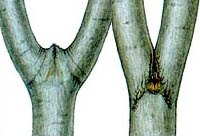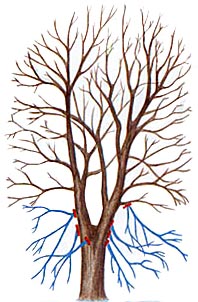
Pruning advice | Part 2
Copyright 2005 - 2011 by M. D. Vaden. Pruning information is divided into Part 1, Part 2, Part 3, Etc. - plus other pruning topics.
Pruning Part 2
Proper pruning cuts are made at a node, the point at which one branch or twig attaches to another. In the spring of the year growth begins at buds, and twigs grow until a new node is formed. The length of a branch between nodes is called an internode. A common types of pruning is Crown thinning, primarily a term for hardwoods. It is selective pruning removal of branches to increase light penetration and air movement throughout the crown. This type of pruning maintains or develop structure and form. To avoid unnecessary stress and prevent excessive sprouts, no more than 25 percent of the living crown foliage and bulk should be removed at a time. If it is necessary to remove more, it should be done over successive years. If a specimen is older, like 50 years or more, remove less at one time, like 15 percent of the living crown. Deadwood removal is virtually without limit.

Branches with strong U shape angles of attachment should be retained. Branches with narrow V shape angles of attachment often form included bark which should be removed if available, preferably when younger. If V attachments are not removed at youth and the stems get large, we may have no choice but to retain them.
Included bark forms when two branches grow at narrow acute angles next to one another, producing a wedge of inward rolled bark between them. The bark is folded inward tightly. Pinched in between. Included bark prevents strong attachment of branches, often causing a crack or split at the point where the branches meet between them. The weakest of that kind can peel apart like a banana peel coming off. Codominant stems are present when the trunk or stem divides into two leaders, side by side. Codominant stems from the same position often form included bark. But occasionally U shape unions which are better and stronger. Removing some of the lateral branches from one codominant stem can reduce its growth enough to allow the other stem to become dominant. Later, that less vigorous stem can be removed or reduced more. That strategy works best when the plant is young. Not very practical once age has set in.

Lateral side branches should be no more than one half to three quarters of the diameter of the stem at the point of attachment.
Avoid producing "lion tail," branches, caused by pruning away too much inner twig and and foliage. Lion tails can result in weak branch structure and breakage. Simply put, lion tails occur when too many inner twigs are removed, leaving a tuft or minimual foliage at the end.

Branches that rub or cross another branch should be removed. Remember should be. Some tree pruning needs should be, but need to remain because it can't be - can't be done. Not every correction is possible. More people discuss how to prune away branches than what can't be removed when pruning. And this separates the hack from the master. Just as important as what to prune away, is what not to prune away or when not to prune.
Conifers that have branches in whorls, pyramidal crowns, rarely need crown thinning except maybe to restore a dominant leader or clean some dead branches out. Occasionally, the leader (it's tip) may be damaged and multiple branches may become codominant by curving upward around the break. Or several new ones will sprout from buds and twigs near the break. Select the strongest leader and remove competing branches to prevent the development of codominant stems. These may need to be pruned away over a period of a few years.
Crown raising is the practice of removing branches from the bottom of a tree to provide clearance for pedestrians, vehicles, buildings, lines of site or to develop a clear stem for timber production. The blue highlighted limbs in the image at left indicate branches to remove for this pruning practice.
For street and curbside, minimum clearance is often specified by ordinance, commonly 8' over the sidewalk and 11' to 14' high over the curb and street. This allows delivery and street maintenance equipment to get by.
After pruning, the ratio of the living crown to total height should be at least two-thirds. If you remove lower limbs, no more than the lower third should be removed. Again, emphasis on should. On young conifers and hardwoods, lower branches may be retained temporarily along the stem to encourage a nice trunk taper and protect trees from various activities and sunburn.
Crown reduction pruning is often used when a tree has grown too large for its space. This method, sometimes called drop crotch pruning, is preferred to topping because it results in a more natural appearance, and increases the time before pruning is needed again: minimizing stress and preventing sunburn. Crown reduction pruning, usually a last resort, often results in large pruning wounds to stems that may lead to decay. This method rarely works well for a pyramidal growth form like many conifers have. But I've seen it work out for some like Austrian pine or Japanese black pine. A better long term solution may be to remove the whole organism and replace it with another species that will not grow beyond the available space.